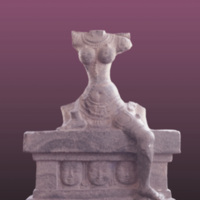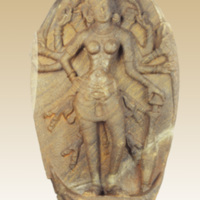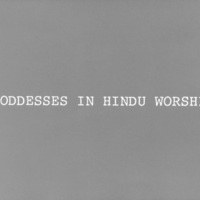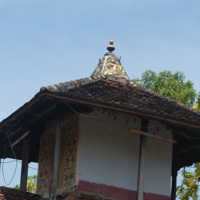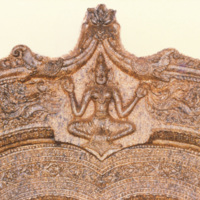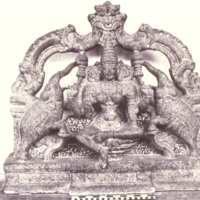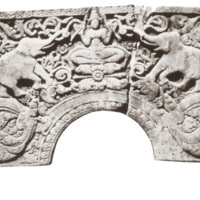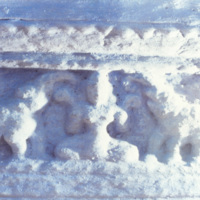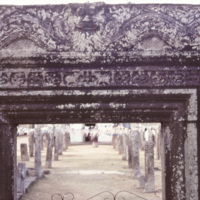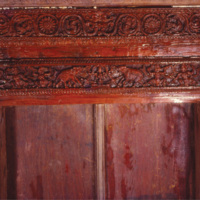Main Menu
AORC Libraries
Browse Archive Items (166 total)
Durgā destroying Ásura
Description: An aspect of Durga, the destroyer of Asura, is represented in this seated, headless stone image from the Colombo National Museum. It may be ascribed to the Cola period of Sri Lanka’s history. Dated in the 11th century A.D.
Contributor: Co-Author: Seneviratna, Harsha
Collection: Women in Sri Lankan Sculpture and Painting
Tags: AISLS, Goddesses in Hindu Worship, ICES, PDWESLSP
Durgā taming a buffalo
Description: This stone image, an eight armed goddess, falls into the category of cult deity. Found near Mihintale, Sri Lanka and perhaps dating to the Cola period, it is presently in the Colombo National Museum. Standing on the head of a buffalo and bearing the traditional weapons associated with Durga, the image, is a representation of the goddess as Mahisasuramardini. Dated in the 11th century A.D.
Contributor: Co-Author: Seneviratna, Harsha
Collection: Women in Sri Lankan Sculpture and Painting
Tags: AISLS, Goddesses in Hindu Worship, ICES, PDWESLSP
Goddesses in Hindu Worship
Description: Goddesses in Hindu Worship: The worship of goddesses is more widespread in Hinduism than in Buddhism. They fall into two broad categories, the goddess venerated as cult deity in her own right and the goddess as female companion of the male god.
Contributor: Co-Author: Seneviratna, Harsha
Collection: Women in Sri Lankan Sculpture and Painting
Tags: AISLS, Goddesses in Hindu Worship, ICES, PDWESLSP
Goddess Lakshmi without elephants
Description: The elevation of goddess Laksmi to the very pinnacle of the main shrine at the Ambakke Devale in the Kandy district, Sri lanka is extremely significant. That it was considered fitting to adorn 3 sides of the brass pinnacle raised above the sanctuary of the male god with a carving of the seated goddess in this 17th century devale, deserves attention.
Contributor: Co-Author: Seneviratna, Harsha
Collection: Women in Sri Lankan Sculpture and Painting
Goddess Lakshmi
Description: Laksmi without the elephants occupies the central position of this very elaborate stone doorway, at the eastern entrance to the Potgul Vihare at Hanguranketa, Sri Lanka. The style and workmanship suggests that it was probably done by a South Indian artist at the court of the Nayakkar Kings of Kandy.
Contributor: Co-Author: Seneviratna, Harsha
Collection: Women in Sri Lankan Sculpture and Painting
4-armed Gajalakshmi
Description: This slide was made from a picture from the Department of Archaeology. It shows a stone relief of the Gajalaksmi symbol, presently found in the Archaeological Museum, Jaffna, Sri Lanka. It was probably associated with a Hindu temple. It is noteworthy that this particular Laksmi is 4-armed whereas the usual Laksmi carving on Buddhist temples displays only 2 arms.
Contributor: Co-Author: Seneviratna, Harsha
Collection: Women in Sri Lankan Sculpture and Painting
Gajalakshmi
Description: Originally found outside the Temple of the Tooth Relic in Kandy, this massive 18th century stone arch with the Gajalaksmi motif now lies outside the Archaeological Museum, Kandy, Sri Lanka, separated into 2 parts. This slide was made from a photograph taken at a time when the two pieces were placed together.
Contributor: Co-Author: Seneviratna, Harsha
Collection: Women in Sri Lankan Sculpture and Painting
Gajalakshmi
Description: A stone doorway of about the 15th century at the Kappagoda Vihare in Mavanella in the Kegalle district, Sri Lanka, carries this Gajalaksmi symbol at the centre of its lintel. Regular whitewashing has given the doorway the appearance of stucco.
Contributor: Co-Author: Seneviratna, Harsha
Collection: Women in Sri Lankan Sculpture and Painting
Gajalakshmi
Description: A Gajalaksmi relief in stone of the 14th century can be seen at Devundara Devalaya in the Matara district, Sri Lanka.
Contributor: Co-Author: Seneviratna, Harsha
Collection: Women in Sri Lankan Sculpture and Painting
Gajalakshmi
Description: Dating to the 14th century is this Gajalaksmi motif at the centre of the wooden door lintel at Uda Aludeniya temple in Gampola, Sri Lanka.
Contributor: Co-Author: Seneviratna, Harsha
Collection: Women in Sri Lankan Sculpture and Painting



